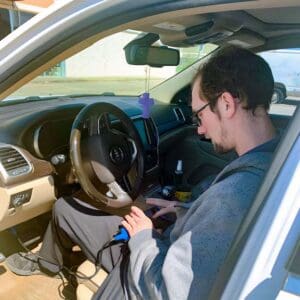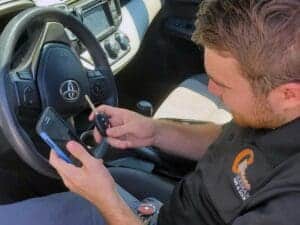Car Key Programming: How It Works
Ever wondered why new keys need to be programmed to start a vehicle, or how car key programming works? Today your local Houston Locksmith Guardian Safe And Lock breaks down this frequently misunderstood process to help you understand how “chip” keys improve your automotive security. To keep things simple, we’ll be organizing different types of car keys by the type of car key programming they use.
These car key programming types include unprogrammed or “metal” key blanks, VATS or “resistor” keys, and PATS which includes modern “transponder” keys. We hope this guide helps to clarify the cost and methods associated with car key replacement, and why programmed keys have become the standard.
How Do Car Keys Work?
Ironically, the best place to start with explaining how car key programming works is with older, chipless, metal blanks. The first cars produced used no keys at all. According to Car And Driver, the first key that turned an ignition cylinder was produced at the turn of the century. However, you still needed to perform a complex procedure to actually start the vehicle. It wasn’t until 1949 that Chrysler introduced the modern car key that starts the car by turning the ignition.
Under this system, keys were single-sided like a house key. There was a different key for the door, ignition, and trunk on most vehicles. In 1965, Ford introduced the first double-sided automotive key. This key allowed for one key to work all locks on the car for the first time. These keys also would work regardless of which direction they were inserted. While all these developments helped to improve convenience for the driver and security of the vehicle, they were still just mechanical. This meant that they were vulnerable to being bypassed by methods such as hotwiring.
The First “Chip” Keys – Vehicle Anti-Theft System
In 1985, despite advances in mechanical “metal” key blanks, auto theft was at an all-time high. General Motors, in particular, noted that Chevrolet Corvette thefts were on the uptick. So, they introduced the Vehicle Anti-Theft System or “VATS” key with the 1986 Corvette.
These keys had a “chip” embedded on the blade that was required to allow the ignition to start. These types of keys are fairly basic compared to today’s system. They didn’t have a computer chip, but a resistor coded to 1 of 15 different levels. This meant that to start the car, you didn’t just need a key that would fit in the cylinder but a matching resistor to complete the circuit. This development made hotwiring nearly a thing of the past and cut auto theft by 40%. By the ’90s, most GM vehicles used this system.
 Modern Transponder Keys – Passive Anti-Theft System
Modern Transponder Keys – Passive Anti-Theft System
By the late ’90s, a new trend also began to emerge in new vehicles of using a transponder system in place of a resistor. Ford unveiled this “Passive Anti-Theft System” under the name of SecuriLock in 1996. This type of car key has a radio frequency transponder embedded in the plastic head with a unique electronic identification code. “Transponder” is a combination of the words radio transmitter and responder.
When the key is physically turned, an antenna array in the steering column releases a radio pulse to this transponder, which responds with its’ unique code. if the codes match, the car starts. Modern vehicles actually use a rolling code system, where multiple codes are pseudo-randomly used and accepted. These newer vehicles are even less likely to have their keys copied by illicit means. Even modern, “keyless” proximity remotes for push-button start cars use a variant of this system.
Car Key Programming In A Nutshell
So now that we know the most common types of car keys, how are they programmed? Truth be told, there’s only one type of key that we’ve discussed today that actually does require car key programming, and it’s the PATS system using radio transponders. Metal key blanks operate mechanically without producing or using an electrical signal themselves, and VATS keys already have a pre-coded resistor on the blade of the key. When a dealer or locksmith programs a key, they’ll usually connect to the car’s OBD port. OBD is an acronym standing for “On-Board Diagnostics” and is the standardized point to communicate with the car’s computer.
Dealers and locksmiths use specialized computers, usually in the form of a tablet computer, to communicate with the car’s onboard computer through this OBD port. These devices will be pre-loaded with the programs needed to communicate with the vehicle and access the anti-theft system. Ironically, this process does nothing to change the key. It merely adds the key’s transponder signature to an existing database that the vehicle checks on each start.
Luckily, despite the ease of use, auto theft remains rarer than before transponders were introduced. Dealer and third-party car key programming hardware and software tend to be restricted, so it’s not as easy as just downloading an app or making a quick online purchase. This leads to a higher price, but also means its’ highly unlikely someone would be able to create an unauthorized key to your car.
Your Local Automotive Locksmith – Guardian Safe & Lock
Luckily for you, Guardian Safe & Lock specializes in automotive locksmithing and car key programming. All of our technicians are licensed, bonded, insured, and fully-trained to make a key for your car. Whether you need deadbolt lock installation on your home, a master key system set-up for your business, a gun safe to safely store your weapons, an Aiphone intercom or commercial security cameras installed on your business, or car key programming for your vehicle; we’re the security specialists to call. Reach out to us at 832-534-8687 for an estimate today!



 Modern Transponder Keys – Passive Anti-Theft System
Modern Transponder Keys – Passive Anti-Theft System